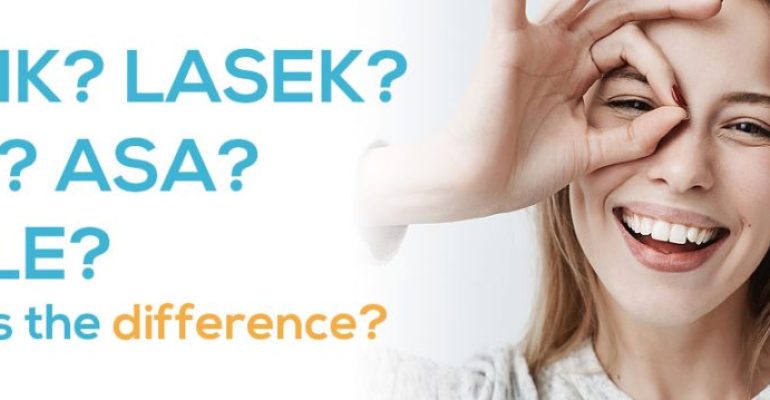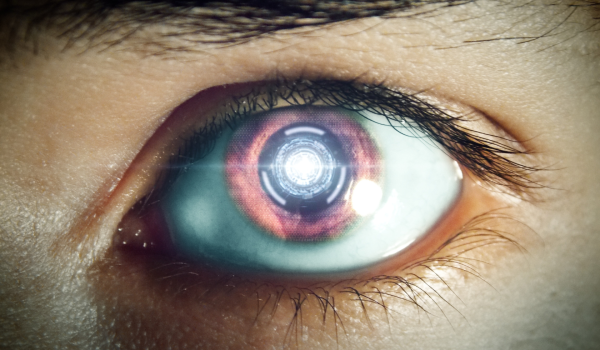Have you ever had the impression that someone’s eyes are glazing over as you speak to them? That the body is present but the mind has drifted through the nearest window? Let me be honest: this is sometimes the reaction I get when I talk to patients about laser eye surgery. Or, to be more precise, about the differences between the major types of laser eye surgery.
Believe me, I do my best to make the subject interesting! But I really can’t blame people for feeling confused by the options. LASIK, LASEK, PRK, SMILE… The terms are somewhat reminiscent of the lower rung of an eye chart – and sometimes similarly opaque.
With that in mind, I thought it would be a good idea to create a simple guide to the surgery types: how they work, and how they differ.
PRK
PRK is where the story of laser eye surgery begins. It was first developed in the 1980s by Columbia University researcher Stephen Trokel, using a then-new technology called the excimer laser.
The first operation on a human patient was performed in 1988 by Trokel’s colleague, Marguerite McDonald, and since then the technique has been used to help many millions of people around the world. PRK stands for photorefractive keratectomy, and it works by removing the surface layer of the cornea –known as the epithelium – in order to reshape the underlying tissue.
The epithelium is a brilliant device. To protect the eye from dust and pollutants, that top layer of cells is continually regenerating itself. Think of it as like those tear-off windscreen stickers used by motorbike racers. And, in layman’s terms, that’s more or less what we do in PRK, albeit in seconds rather than weeks.
The surgeon places a tiny well on the surface of the eye. A few alcohol drops dissolve the epithelium (in the knowledge that the cornea will grow a new one within a few days). And then an excimer laser swiftly reshapes the newly-exposed layer of cornea (the corneal stroma) to correct the vision problem.
Who does it suit?
PRK is particularly useful for people with thin corneas and certain medical conditions affecting their eyes. This also helps to explain why people at risk of eye injuries tend to opt for PRK; boxers, rugby players and soldiers often prefer the procedure, since it eliminates the (admittedly small) risk of future ‘flap’ complications.
The other advantage of PRK is that it can be used for patients with medical conditions affecting their cornea, where surface treatment is preferable. And the disadvantages? The main one revolves around the recovery process.
The eyes can take a week or more to heal following surgery, and are likely to feel quite uncomfortable for the first few days. That said, we can mitigate any pain with a good course of painkillers – as I found myself when I had PRK some years ago.
ASA (also known as LASEK)
ASA stands for advanced surface ablation. Rather a mouthful, perhaps. What you need to know in essence, though, is that it corrects vision in the same way as PRK. In fact most surgeons will use the terms interchangeably.
Surgery takes place on the corneal surface and an advanced laser re-sculpts the tissue. The main difference with ASA (or LASEK, as it’s also often known) is that we don’t remove the epithelium during the procedure.
Instead, we create a small ‘flap’ in those cells, which is gently placed to one side for a few seconds while the excimer laser does its work on the underlying cornea.
In most cases the flap is then put back in place, supplemented by a soft contact lens to aid the healing process.
Who does it suit?
LASEK is a good fit for a wide variety of vision issues, including nearsightedness, longsightedness and astigmatism. Just like PRK, it’s an excellent option for people with thin corneas, or with a greater risk of injuries from high-impact sports.
Since we are replacing the epithelium, some have argued that LASEK also results in a more comfortable recovery. That said, the healing process does take time – we would usually expect some discomfort in the immediate aftermath, again supplemented by a soft contact lens, with normal vision returning within two days to a week of surgery.
LASIK
Having covered LASEK, let’s now explore its similar-sounding sibling. LASIK, which stands for laser assisted in-situ keratomileusis, has been in use for around 25 years. What’s the big difference?
Essentially, it’s in how we create that pre-surgery flap. With LASIK, an exceptionally precise femtosecond Visumax laser forms the flap in the eye by creating a plane of micro-bubbles, about 100 microns below the surface (the bubbles dissolve naturally following surgery).
Once this tiny section has been peeled back, a second laser is used to correct the vision impairment. The whole procedure takes a matter of seconds. But the big plus with LASIK is what happens next. Because the epithelium remains intact, your vision is optically excellent from the get-go.
Many patients are able to return to work within 24 hours. Most can expect to have 20-20 vision within a day or two. This is the real ‘wow factor’ of LASIK. My patients often describe the instant results as miraculous, and it feels like that to me sometimes, too.
Who does it suit?
A big plus of LASIK is that it suits most people – the short-sighted, the long-sighted, and patients with astigmatism. As mentioned, the results are very quick, and the recovery is usually very comfortable. Most people with ‘normal’ eyes, therefore, tend to choose LASIK above other treatments.
LASIK is generally unsuitable for people with thin corneas, or who suffer from very dry eyes. There is also a risk of flap complications – I have to add, though, that these are very rare, and they can usually be corrected with a follow-up operation.
SMILE
If PRK is the grandfather of laser eye surgery, SMILE is the new kid on the block. It first entered the market in the 2000s and is becoming one of the most popular treatments available; more than 1.5 million treatments have been performed to date.
In fact the good news is that we now offer it here at Anderson Eye Care; until recently it was only available in London and one or two other centres nationally. It has the friendliest-sounding acronym, too – SMILE actually stands for small incision lenticule extraction (though some people also refer to it as ‘Keyhole LASIK’).
As the name implies, it works by using a femtosecond laser to create what is known as a lenticule within the cornea. A small 2-3mm gap is then made in the surface of the cornea with the laser and the lenticule is removed, changing the shape of the cornea, which corrects the visual impairment.
Who does it suit?
SMILE can treat a wide range of patients from severe short-sightedness to astigmatism. As a ‘flapless’ procedure, it may be more suitable for patients with dry eyes and other ocular-surface problems.
The essential stability of the cornea is also maintained, since SMILE preserves that front 100 microns of tissue during treatment. That means that a return to activities is much quicker, from swimming or contact sports to wearing and removing eye makeup.
Best of all, SMILE results in a speedy and more comfortable recovery – though vision may initially be blurry for slightly longer than in LASIK.
Thanks for listening!
So that completes my brief summary. I hope you find it helpful. Let me conclude by adding that, as with all eye treatments, the reasons for choosing one surgery over another will change from person to person.
The only way to know which one is best for you is, of course, to get an expert opinion.
If you’re seriously considering one of these excellent treatment options, why not book an appointment here at Anderson Eye Care? We would be delighted to help you look through the possibilities.
Equally, if you aren’t suitable for these treatments, we are able to offer a full range of other refractive surgery procedures, such as ICL surgery or lens replacement.
Medical Disclaimer
This article is for information purposes only and should not be considered medical advice. If you or any other person has a medical concern, you should consult with your health care provider or seek other professional medical treatment. Never disregard professional medical advice or delay in seeking it because of something that you have read on this blog, website or in any linked materials.







